
The E-class lifeboat forms part of the RNLI fleet in the United Kingdom, operating exclusively in the tidal reach of the River Thames in London. The class was introduced in 2002 to serve the tidal reach of the River Thames, which had not previously been covered by an RNLI rescue service, as a result of a much delayed enquiry into the Marchioness disaster in 1989, in which 51 people died. The enquiry criticised the lack of a rescue service for the tidal Thames, and the UK government asked the Maritime and Coastguard Agency, the Port of London Authority and the RNLI to work together to set up a dedicated Search and Rescue service for this stretch of the river.

Walmer Lifeboat Station is located on The Strand on Walmer promenade, in the county of Kent.

Teddington Lifeboat Station is a lifeboat station in Teddington, in west London, on the River Thames. It is one of the Royal National Lifeboat Institution (RNLI)'s newest lifeboat stations and is also one of the first to cover a river rather than estuarial waters or the sea. Teddington Lock is the highest tidal point on the Thames.
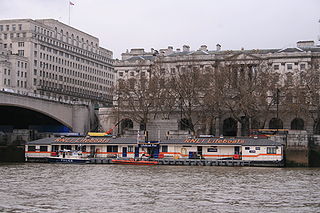
The Tower Lifeboat Station is a lifeboat station on the River Thames in London, UK, operated by the Royal National Lifeboat Institution (RNLI). It is located at Victoria Embankment on the North Bank of the Thames, next to Waterloo Bridge.
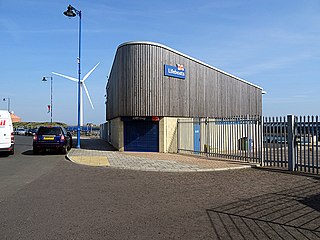
Blyth Lifeboat Station is located at the Port and seaside town of Blyth, in the south east corner of the county of Northumberland, approx. 13 miles (21 km) north of Newcastle upon Tyne.

Porthcawl Lifeboat Station opened in 1860 and a boathouse was subsequently built on the promenade to house the lifeboat. This station was closed in 1902 when Porthcawl Dock was closed.
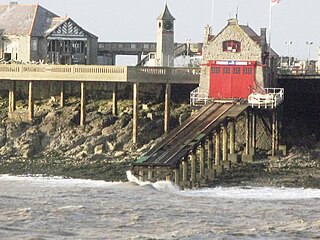
Weston-super-Mare Lifeboat Station is a lifeboat station at Weston-super-Mare in Somerset, England. For more than 100 years it was situated on Birnbeck Island but is now in a temporary building at Knightstone Harbour until a new lifeboat station can be built nearby. It is operated by the Royal National Lifeboat Institution (RNLI). The first lifeboat was stationed in the town in 1882, and since 1969 it has only operated inshore lifeboats (ILBs), currently a B-class and a smaller D-class (IB1).

The Southend-on-Sea lifeboat station is a lifeboat station at Southend-on-Sea in the English county of Essex, operated by the Royal National Lifeboat Institution (RNLI) since 1879.
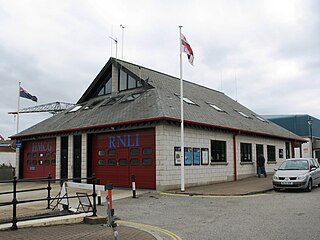
Falmouth Lifeboat Station is the base for Royal National Lifeboat Institution (RNLI) search and rescue operations at Falmouth, Cornwall in the United Kingdom. The first lifeboat was stationed in the town in 1867 and the present station was opened in 1993. It operates a Severn Class all-weather Lifeboat (ALB) and an Atlantic 85 inshore lifeboat (ILB).

St Ives Lifeboat Station is the base for Royal National Lifeboat Institution (RNLI) search and rescue operations at St Ives, Cornwall in the United Kingdom. The first lifeboat was built for the town in 1840 and the present boathouse was opened in 1994. It operates a Shannon-class All-weather boat (AWB) and a D-class (IB1) inshore lifeboat (ILB).

Ilfracombe Lifeboat Station is the base for Royal National Lifeboat Institution (RNLI) search and rescue operations at Ilfracombe, Devon, England. The first lifeboat was stationed in the town in 1828 and the present station was opened in 1996. For 29 years a second boat was operated from Morte Bay at Woolacombe.

Burnham-on-Sea Lifeboat Station is the base for Royal National Lifeboat Institution (RNLI) search and rescue operations at Burnham-on-Sea, Somerset in England. A lifeboat was stationed in the town from 1836 until 1930. The present station was opened in 2003. It operates two inshore lifeboats (ILBs), a B-Class rigid-inflatable boat and an inflatable D-Class.
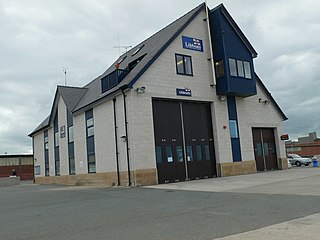
Rhyl Lifeboat Station is operated by the Royal National Lifeboat Institution (RNLI) in the North Wales town of Rhyl. For over 150 years, the Lifeboat Crew in Rhyl have been saving lives at sea. The first lifeboat was stationed in the town in 1852 and the present station was opened in December 2001. The station operates a Shannon-class All-weather lifeboat (ALB), and an D-class (IB1) Inshore lifeboat (ILB).
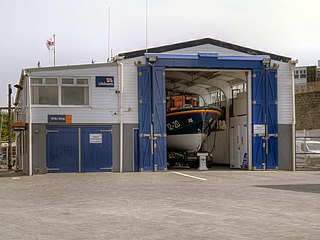
Margate Lifeboat Station is a Royal National Lifeboat Institution (RNLI) station located in Margate in the English county of Kent. The station is over 160 years old. Its crews have earned a number of gallantry awards, including five silver and 1 bronze RNLI medals for bravery.

Littlehampton Lifeboat Station is located in the town of Littlehampton, in West Sussex, on the south coast of England.The station is on the harbour side on the eastern bank of the River Arun, a quarter mile from the harbour entrance and the pier. The current lifeboat house on Fisherman's Quay was built in 2002.

Eastbourne Lifeboat Station is a Royal National Lifeboat Institution (RNLI) lifeboat station in the town of Eastbourne in East Sussex. Founded two years before the RNLI was established, the station has operated continuously since 1822, and its lifeboats have been responsible for saving over 700 lives.

Eyemouth Lifeboat Station is located at the harbour town of Eyemouth, in the Scottish Borders, Scotland.

Chiswick Lifeboat Station is a lifeboat station on the north bank of the River Thames at Corney Reach, Chiswick, in west London. It is one of the newest stations operated by the Royal National Lifeboat Institution (RNLI), and one of the first to cover a river rather than estuarial waters or the sea.
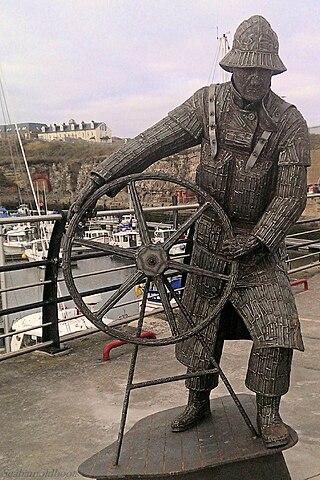
Seaham Lifeboat Station is a former Royal National Lifeboat Institution (RNLI) station, which was located at the harbour town of Seaham, in County Durham.

Wicklow Lifeboat Station is located at East Pier in the county town of Wicklow, County Wicklow, a harbour town at the mouth of the River Vartry, on the east coast of Ireland.
























